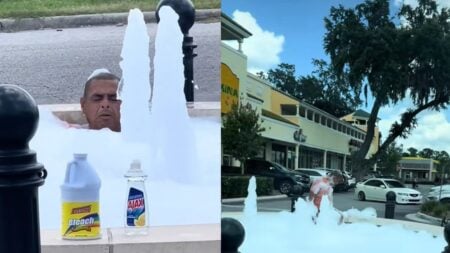In a moment captured on video, federal ICE agents violently slammed an Indigenous mother to the ground as she clutched a protest sign. Her daughter stood nearby. The backdrop: a protest against the expansion of a controversial Immigration and Customs Enforcement (ICE) facility already at the heart of an ecological crisis and cultural reckoning.
The expansion zone, tucked into the wetlands surrounding Portland, Oregon, includes an area considered sacred to Indigenous communities: the ancestral home of the wapato plant. Once a critical food source for tribes such as the Chinook and Kalapuya, wapato has thrived in these wetlands for centuries, but its habitat is now under siege.
ICE’s development plan has razed native plant beds, dug trenches for surveillance infrastructure, and turned floodlights and concrete barriers on land that once fed not only people, but muskrats, waterfowl, and an entire ecosystem. Activists say chemical agents, including herbicides and riot control substances, have leached into the soil and runoff systems, repeating environmental damage first reported during the 2020 Black Lives Matter protests.
“They are hiring people that fantasize about this stuff,” wrote Reddit user Early-Series-2055, summing up the sentiment in a viral thread that exploded after footage of the incident surfaced. Other commenters were more direct: “State-sanctioned terror squads,” “Gestapo-shaped,” and “This is why they wear masks.”
To the federal government, this is about expanding a critical enforcement infrastructure. To the communities affected, it’s a slow erasure of people, of land, and of memory.
For many Indigenous residents, the wetlands represent far more than a conservation issue. The wapato root isn’t just a plant — it’s an ancestral legacy. Elders teach children to harvest it by hand, wading through shallow waters in the same way their ancestors did. Losing it means losing part of their identity.
“It’s cultural genocide under the banner of homeland security,” said a protester on site who asked to remain anonymous. “And when we show up to protect what’s ours, we’re met with armored trucks.”
Despite multiple reports submitted to the Environmental Protection Agency, the expansion has gone largely unchecked. Community watchdogs allege widespread use of unregulated herbicides, poorly managed burn pits, and unchecked construction. Photos show tactical vehicle tracks tearing through wetland beds, some still littered with uprooted wapato.
A 2022 environmental impact memo quietly released by the DHS admitted “temporary disruptions” but denied lasting damage — a claim local ecologists flatly reject. “You can’t trench a wetland and expect it to bounce back,” said Dr. Lena Montour, an environmental scientist who’s been monitoring the site since 2019.
The woman seen in the now-viral video had come to the protest with her young daughter. She was not masked, not aggressive. Her sign read simply: “Honor the Land, Honor the People.” Witnesses say she was trying to de-escalate a confrontation when ICE officers rushed forward. Moments later, she was on the pavement.
No charges have been announced against the agents involved. There has been no federal statement. Community leaders have called for immediate disciplinary action and a federal inquiry, but expectations are low.
“This is what happens when the state has no one left to answer to,” said a community advocate during a candlelight vigil the following evening. “They brutalize the very people trying to heal the wounds they create.”
The incident has reignited broader fears about militarized federal agencies operating in civilian spaces, especially when those spaces are sacred, fragile, and already burdened by the legacy of colonization.
Reddit user Contagious_Zombie put it bluntly: “There shouldn’t be state-sanctioned terror squads running around abducting and abusing people. What they are doing is far, far worse than overstaying on a visa.”
The fight for the wetlands, for the wapato, and for justice is far from over. But for many, the image of a mother being hurled to the ground while defending her culture may become the rallying cry that unites environmentalists, Indigenous activists, and human rights defenders alike.








